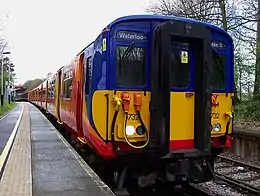Chessington branch line
The Chessington branch line is a short National Rail railway line in England, mostly in the Royal Borough of Kingston upon Thames, from Motspur Park to Chessington South.
| Chessington branch line | |||
|---|---|---|---|
 Class 455 at Chessington South | |||
| Overview | |||
| Status | Operational | ||
| Owner | Network Rail | ||
| Locale | Greater London | ||
| Termini | Motspur Park Chessington South | ||
| Stations | 4 | ||
| Service | |||
| Type | Suburban rail | ||
| System | National Rail | ||
| Operator(s) | South Western Railway | ||
| Depot(s) | Wimbledon | ||
| Rolling stock | British Rail Class 455 British Rail Class 456 | ||
| History | |||
| Opened | 1938–1939 | ||
| Technical | |||
| Number of tracks | 2 | ||
| Character | Suburban branch | ||
| Track gauge | 4 ft 8 1⁄2 in (1,435 mm) standard gauge | ||
| Electrification | 750 V DC third rail | ||
| |||
| Chessington branch line | |||||||||||||||||||||||||||||||||||||||||||||||||||||||||||||||||||||||||||||||||||||||||||||||||||||||||||||||||||||||||||||||||
|---|---|---|---|---|---|---|---|---|---|---|---|---|---|---|---|---|---|---|---|---|---|---|---|---|---|---|---|---|---|---|---|---|---|---|---|---|---|---|---|---|---|---|---|---|---|---|---|---|---|---|---|---|---|---|---|---|---|---|---|---|---|---|---|---|---|---|---|---|---|---|---|---|---|---|---|---|---|---|---|---|---|---|---|---|---|---|---|---|---|---|---|---|---|---|---|---|---|---|---|---|---|---|---|---|---|---|---|---|---|---|---|---|---|---|---|---|---|---|---|---|---|---|---|---|---|---|---|---|---|
| |||||||||||||||||||||||||||||||||||||||||||||||||||||||||||||||||||||||||||||||||||||||||||||||||||||||||||||||||||||||||||||||||
History
The branch, double track and electrified on the DC third-rail system (660 V at the time of its construction), was the last line built by the Southern Railway. It was to serve the housing, industrial, engineering and storage developments south of Surbiton and secondly, never realised, to form a corollary line to Leatherhead.
It was opened on 29 May 1938 from Motspur Park to Tolworth, with an intermediate station at Malden Manor, and extended on 28 May 1939 to Chessington North and Chessington South.
All the stations on the line were of concrete in an Art Deco style, typical of the period.
Work to extend beyond Chessington was halted by the outbreak of World War II, with track laid beyond Chessington South as far as Chalky Lane, and preparatory works continuing further south. This included an embankment built by the Royal Engineers as a military exercise from Chalky Lane as far south as Chessington Wood, close to where the next station at Malden Rushett would have been built. A second station to serve Ashtead, namely at its northern extreme, was also planned.[1] After the war green belt legislation put a stop to any resumption because Ashtead Common was given protective status. A goods yard south of Chessington South was used as a coal concentration depot from the mid-1960s to the end of the 1980s. The goods yard and the 0.5 miles (0.80 km) of trackbed towards Malden Rushett are overgrown by trees. Two platforms were built at Chessington South but as a result of the truncation, only one platform has ever been in public use.
It was originally intended to name Chessington North station Chessington Court and Chessington South station Chessington Grange.[2]
The line was mainly constructed on embankment with short distances in cuttings and several bridges. A 140-foot (43 m) viaduct crosses the Hogsmill River near Malden Manor.
Demand and population in the area increased after the railway's relatively late introduction. Malden Manor station is the line's busiest with 0.60 million journeys made in the 2014-2015 financial year. Its recorded use was 0.58 million ten years before. The total of journeys per year of the four stations on the line has reached 2.219 million recorded journeys. Malden Manor station has formally been assigned E (small staffed) status as its station category.[3]
References
- "New Southern Railway Suburban Line" (PDF). The Railway Magazine: 25. July 1938. Retrieved 28 June 2015.
- Vic Mitchell and Keith Smith, Wimbledon to Epsom, Middleton Press, Midhurst, 1995, ISBN 1 873 793 62 6
- "Part D: Annexes" (PDF). Better Rail Stations. Department for Transport. 2009. p. 105. Archived from the original (PDF) on 6 June 2011. Retrieved 1 May 2016.
External links
| Wikimedia Commons has media related to Chessington Branch Line. |
Illustrated article on Malden Manor station at this illustrated article on Malden Manor station

